BSC1010 Final Exam
1/85
There's no tags or description
Looks like no tags are added yet.
Name | Mastery | Learn | Test | Matching | Spaced |
|---|
No study sessions yet.
86 Terms
Heterozygous
having two different alleles for a trait (ex. Tt, Rr, Ww, Yy)
Joseph Kölreuter
created the first systematic studies of genetic crosses from 1761 to 1766 between different strains of tobacco plants
-found that the offspring were usually intermediate in appearance between the two parents
-the factors that dictate hereditary traits can blend together from generation to generation

Johann "Gregor" Mendel
- the father of genetics
- grew up on a small farm
- first name changed to Gregor when he joined the monastery
- began famous pea plant (Pisum sativa) experiment in 1853
- published his work, entitled Experiments on Plant Hybrids, in 1866
- sixteen years later, in 1900, the work of Mendel was independently rediscovered by three biologists with an interest in plant genetics
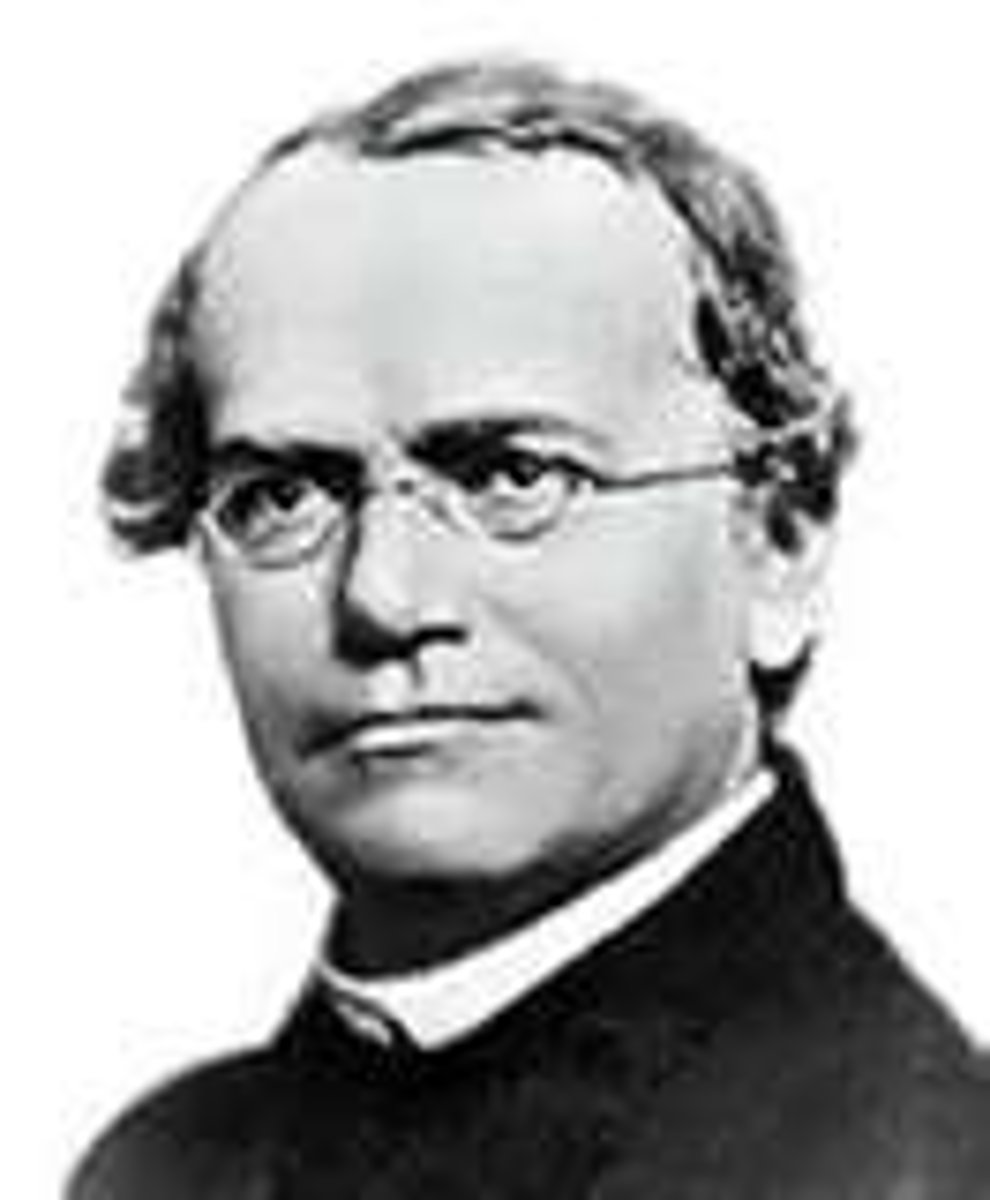
Name the 6 reasons why studying pea plants was advantageous to Mendel's experiment.
1. easy to grow
2. exhibits many visual and observable traits
3. exhibits very little genetic variation
4. bears its fruits and flowers in the same year in which the seed is planted
5. produces a large number of seeds
6. it is monoecious having both male and female parts and hence can be easily self-fertilized

Monohybrid Cross
a cross where a single characteristic is being examined (MONO =single or one) by crossing two parents that have contrasting forms of that characteristic (i.e.Tall/Short) and results in producing a hybrid of those contrasting forms—a mono hybrid
Cross Fertilization
fertilization of one plant by pollen from a different plant
Briefly explain how Mendel was able to cross fertilize the pea plants that he studied and used for his experiment.
- Mendel was able to pry open immature flowers and remove the anthers before they produced pollen (emasculation)
- these flowers were now solely female (diecious) and could not self-fertilize.
- he then obtained pollen from another plant by gently touching its mature anthers with a paintbrush
- Mendel applied this pollen to the stigma of the flower that already had its anthers removed
True Breeding
term used to describe organisms that produce offspring identical to themselves if allowed to self-pollinate
Pure Breeding
individuals that are homozygous and will always produce the same offspring when crossed together
Know true breeding or pure breeding in genetics problems is code for ________________________.
HOMOZYGOUS; a true breeding Tall Pea plant = TT; A true breeding purple flowered pea plant= PP; A true breeding short pea plant= tt; A true breeding green pea plant= yy; A true breeding Yellow pea plant= yy (Yellow=YY-dominant Green=yy-recessive)
What are the 7 characters that Mendel studied?
1. PLANT HEIGHT (tall and dwarf variants) Tall = Dominant
2. FLOWER COLOR (purple and white variants) Purple = Dominant
3. FLOWER POSITION (axial and terminal variants) Axial = Dominant
4. SEED COLOR (yellow and green variants) Yellow Seed(Pea) = Dominant
5. SEED SHAPE (round/smooth and wrinkled variants) Round/Smooth = Dominant
6. POD COLOR (green and yellow variants) Green Pod (Fruit) = Dominant
7. POD SHAPE (inflated and constricted variants) Inflated = Dominant
Law of Segregation
Mendel's law that states that the pairs of homologous chromosomes separate in meiosis so that only one chromosome from each pair is present in each gamete
Single-factor cross
a cross in which an experimenter observes one character
Monohybrids
a cross between two parents with different variants for ONE given character will produce single-character hybrids
Phenotype
An organism's physical appearance, or visible traits (ex. curly hair, brown eyes, brown skin)
Genotype
- the letter representation for the genetic makeup of an organism
Homozygous Recessive
Both alleles for a trait are the same and recessive (ex. tt, rr, ww, yy)
Homozygous Dominant
Both alleles for a trait are the same and dominant (ex. TT, RR, WW, YY)
Know the following about Mendel's Monohybrid Crosses
1. began with true-breeding plants that differed in a single character (ex. a true breeding Tall Plant and a true breeding Short Plant differ in the Character of Height)
2.these true breeding plants are termed the parental generation, or P generation
3. he then crossed true-breeding parents to each other (this is called a P cross)
4.Mendel's P cross of true breeders produced the offspring that constitute the F1 generation (the F stands for first filial generation)
5. all plants generated by the P cross (the F1 generation) showed the trait of one parent but not the other (no blend)
(ex. Mendel crossed Tall Plants with Short Plants - He then collected the seeds aka (peas) which are the embryonic children of the Tall and Short parents. He then planted the peas, and the seeds grew...leading to the adult fully grown pea plants -the offspring-- of the F1 generation.) He then examined the F1 adult fully grown pea plants and found they all were Tall with none being short.)
6. Mendel more than likely wondered what happened to the short trait in the F1 and likely may have also reasoned that the short trait might skip a generation.
(ex. Mendel's eye color (blue) was the same as his grandparents (blue) but not the same as his parents (brown). His eye color from his grandparents skipped a generation. So maybe short plants (that were not present in the F1 at all) would skip a generation and show up in the next round)
7. to test this hypothesis, Mendel self-fertilized the plants of the F1 generation (the tall ones)
Monohybrid Cross Diagram
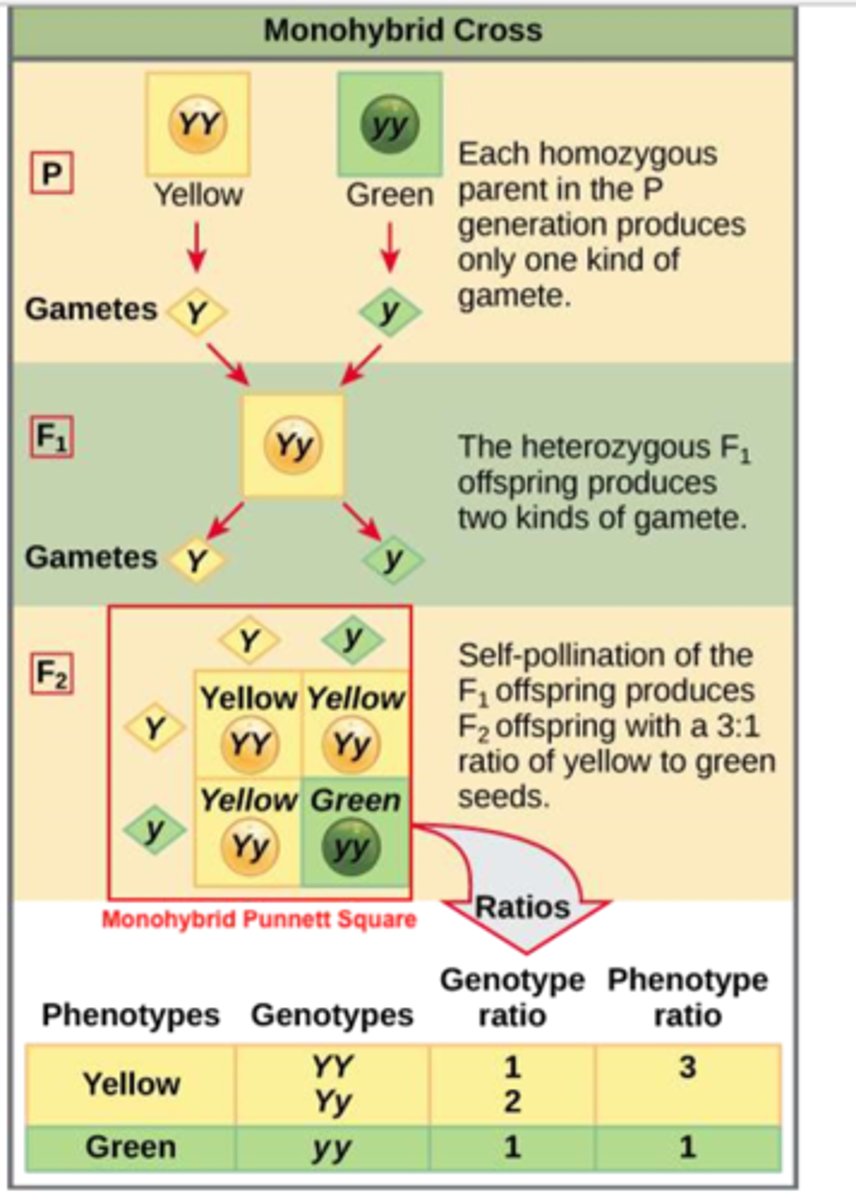
Mendel's data revealed (what he was trying to prove) __________________________.
patterns of inheritance
Mendel's 4 Conclusions from his Experiment
1) Mendel's data argued strongly against a blending mechanism of heredity. (In all seven cases, the F1 generation displayed characteristics that were distinctly like one of the two parents rather than traits intermediate in character.)
2) His data suggested that the genetic determinants of traits are passed along as discrete "unit factors" from generation to generation. (His data were consistent with a particulate theory of inheritance, in which the genetic determinants that govern traits are inherited as discrete units that remain unchanged as they are passed from parent to offspring. They don't blend. Mendel referred to the genetic determinants as unit factors we now call them genes.)
3) Mendel stated that........unit factors occur in pairs. When one unit factor for a particular character is present simultaneously with a second distinct unit factor within the same individual—one of the factors will be dominant over the other variant of the factor which will said to be recessive. (The term recessive is used to describe a variant that is masked by the presence of a dominant trait but reappears in subsequent generations. When a true-breeding plant with a dominant trait was crossed to a true-breeding plant with a recessive trait, the dominant trait was always observed in the F1 generation the other trait was hidden or masked or recessed.)
4) Mendel also stated that... genes must segregate from each other during the process that gives rise to gametes (Now called Meiosis I Anaphase I). (In his experiments most F2 offspring displayed the dominant trait, but some showed the recessive trait.)
Alleles
- (from the Latin alius meaning other) refers to an alternative version of a particular gene.
- each allele appears on its' own separate homologous chromosome (in meiosis these homologs pair up closely in Pachynema of Meiosis I of Prophase I. The maternal and paternal alleles sit side by side in the paired homolog structure)
- anaphase I segregates the dominant allele on the maternal homolog from the recessive allele on the paternal homolog. Sending them to opposite poles and, therefore, only one copy of each allele/gene form is found in the final gametes
- ½ of the sperm will have the chromosome with the dominant allele. the other ½ of the sperm will have the chromosome with the recessive allele
- at fertilization, two gametes combine randomly, potentially producing different allelic combinations (ex. a sperm with the dominant allele combines with and fertilizes and egg carrying a recessive allele to produce a hybrid.
Punnett Square
A chart that shows all the possible combinations of alleles that can result from a genetic cross
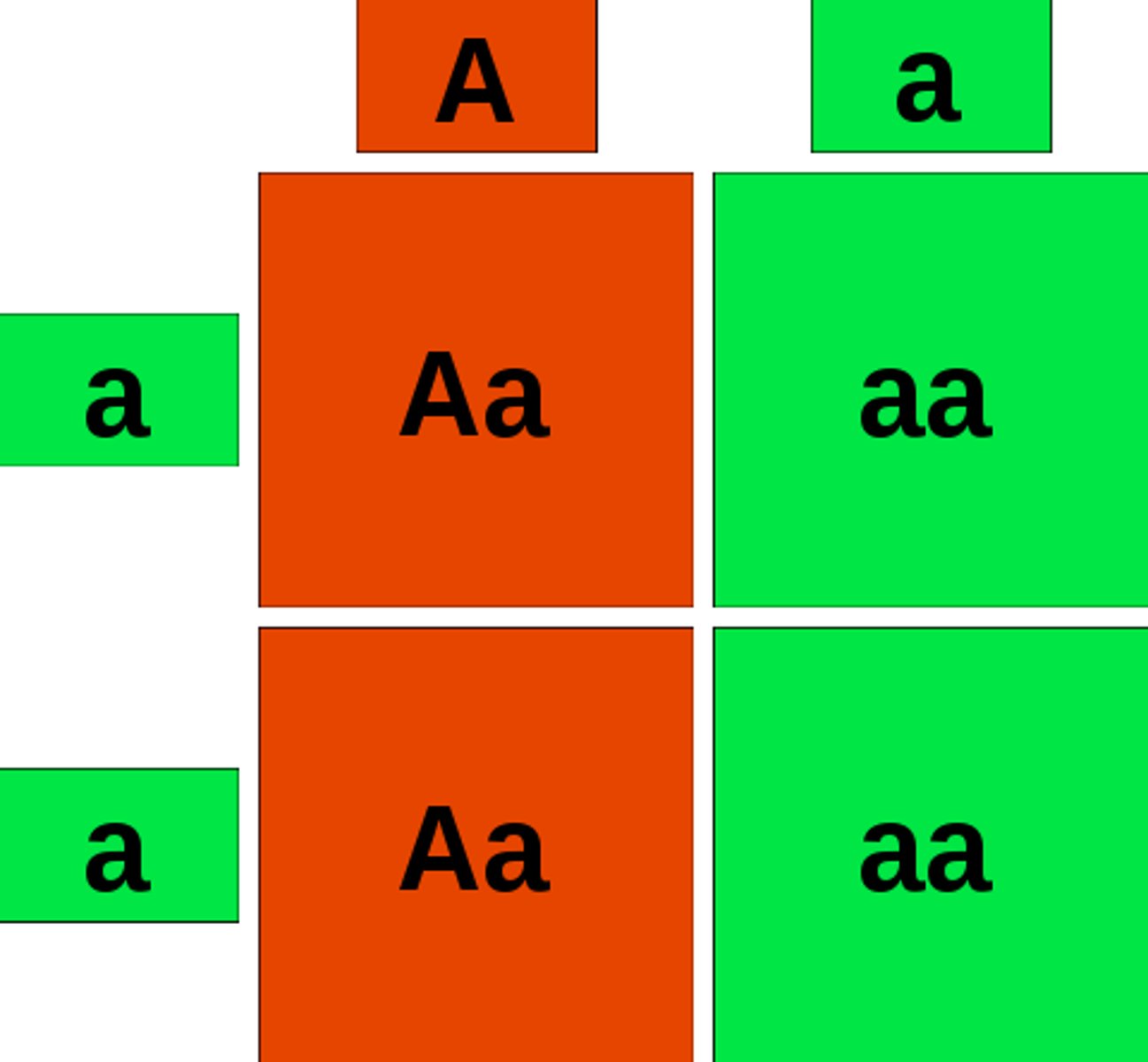
Phenotypic Ratio
the ratio of phenotypes produced by a cross (ex. tall:short)
Genotypic Ratio
the ratio of the genotypes that appear in offspring (ex. 3:1)
Dihybrid Cross
A cross between individuals that have different alleles for the same gene
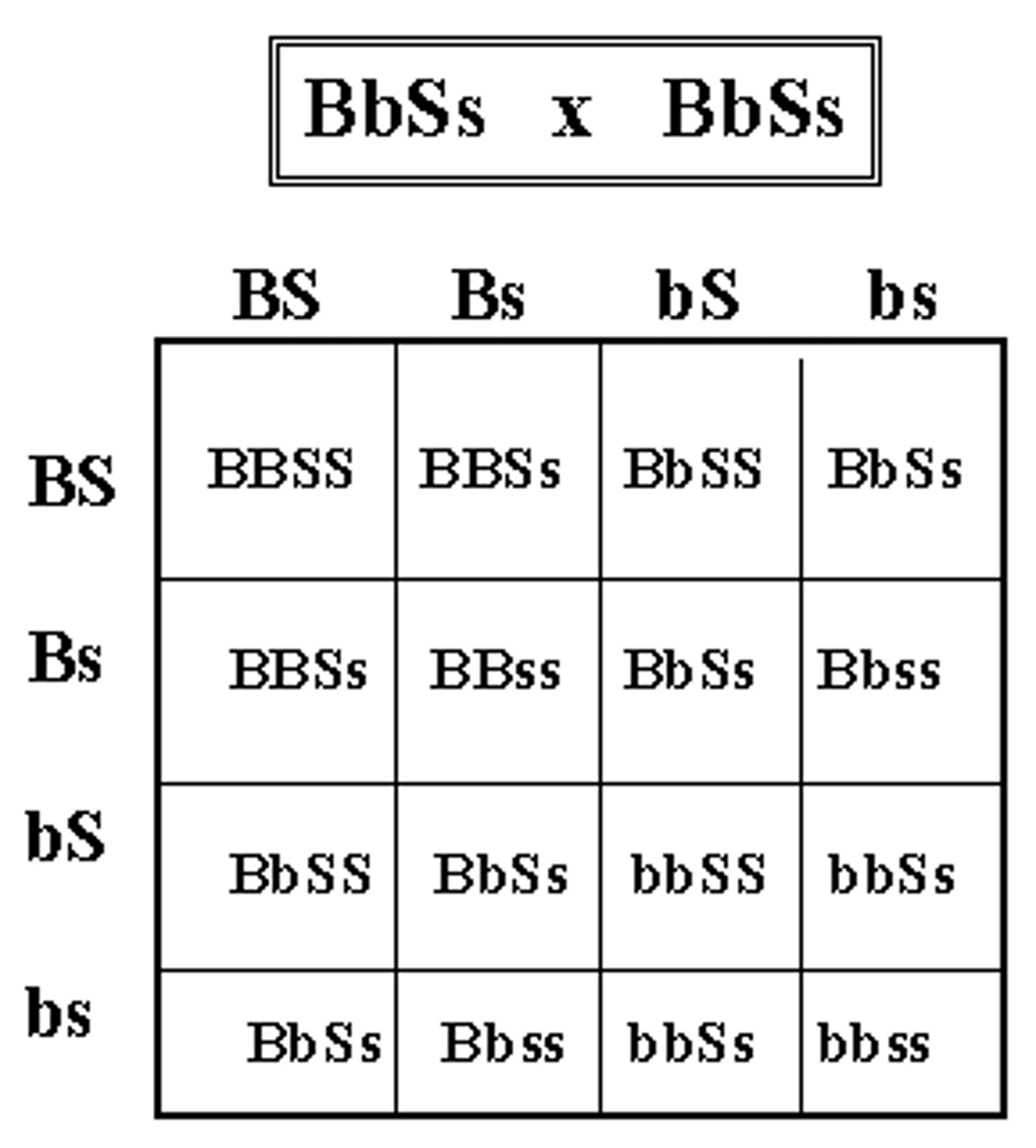
Law of Independent Assortment
- states that when two or more characteristics are inherited, individual hereditary factors assort independently during gamete production, giving different traits an equal opportunity of occurring together (ex. For Gene A, A and a alleles on two homologous chromosomes segregate on the metaphase plate during anaphase I INDEPENDENT of Gene B where B and b alleles on a 2nd pair of chromosomes are also segregating
- this law describes how different genes independently separate from one another when reproductive cells develop
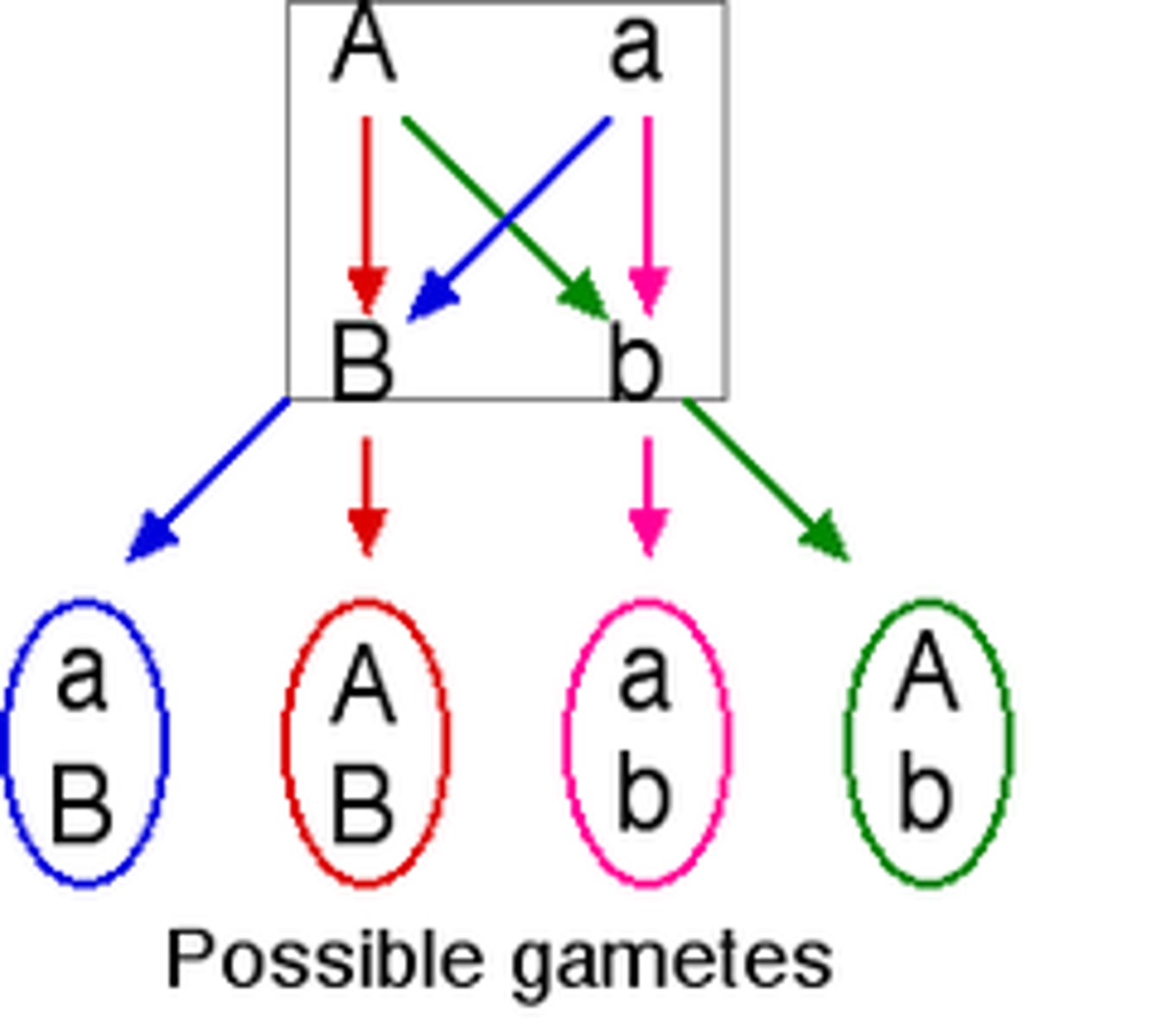
Test Cross
the crossing of an individual of unknown genotype with a homozygous recessive individual to determine the unknown genotype
Pedigree
A chart or "family tree" that tracks which members of a family have a particular trait (remember that men = square and women = circle; in post pedigrees, affected individuals are shaded or colored in)

Name 2 autosomal dominant genetic diseases that can be detected via pedigree analysis.
Huntington's disease and Achondroplasia
Name 2 autosomal recessive genetic diseases that can be detected via pedigree analysis.
Albinism and Cystic Fibrosis
Complete Dominance
occurs when phenotypes of the heterozygote and dominant homozygote are identical
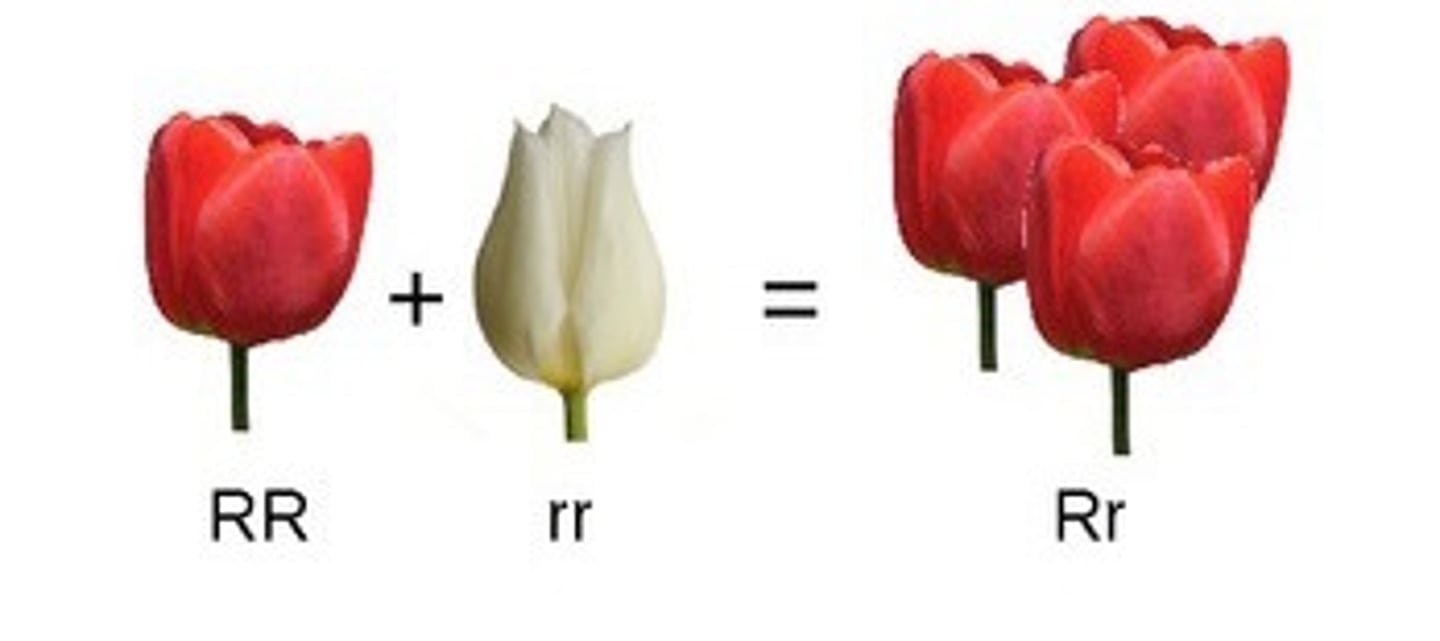
Incomplete Dominance
the phenotype of F1 hybrids is somewhere between the phenotypes of the two parental varieties (produces a blend)
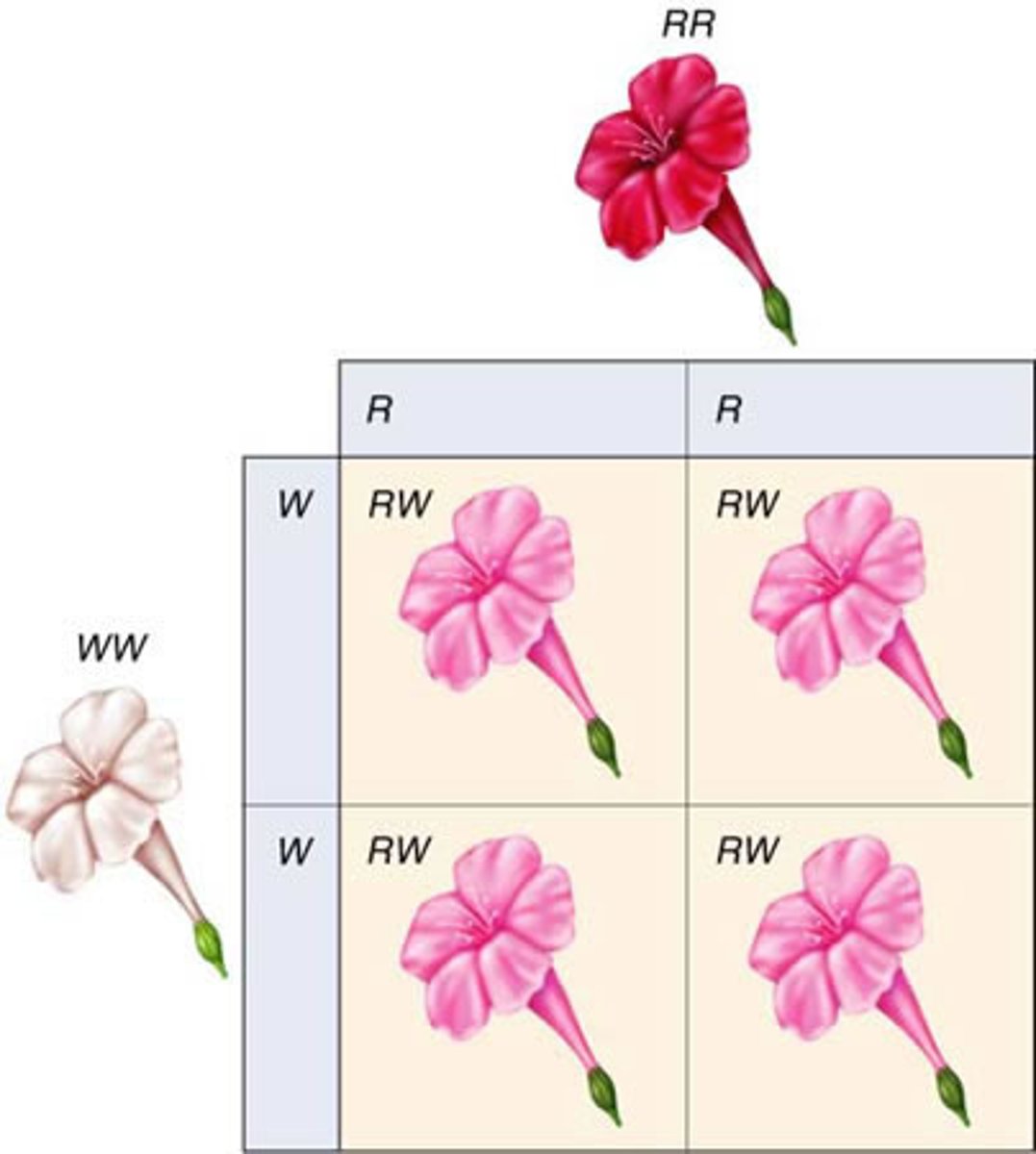
Codominance
two dominant alleles affect the phenotype in separate, distinguishable ways (ex. mixing salt and pepper; the substance will make a mixture, but you are still able to depict the pepper corns from the course salt)
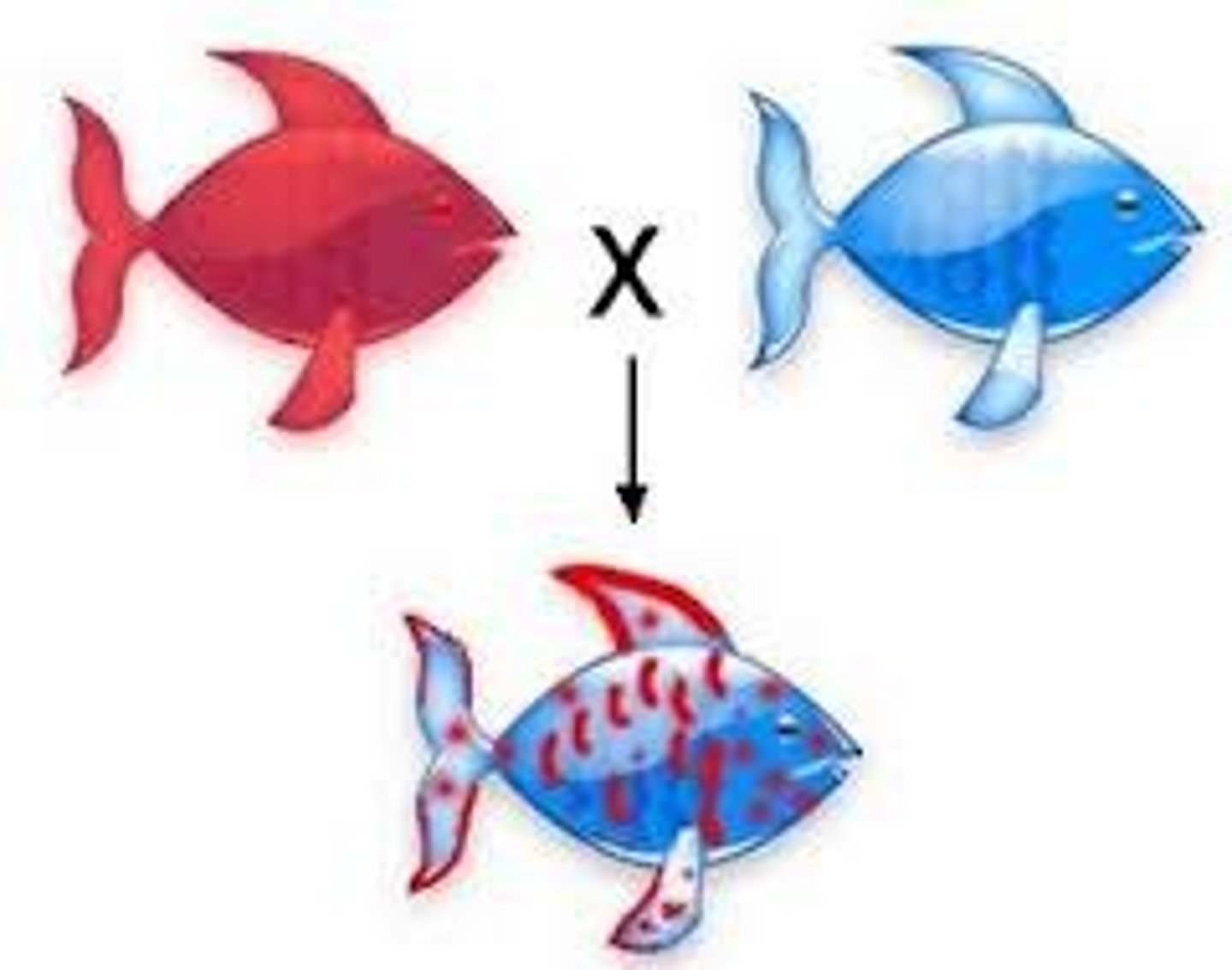
Pleiotropy
A single gene having multiple effects on an individuals phenotype (ex. sickle cell and cystic fibrosis)
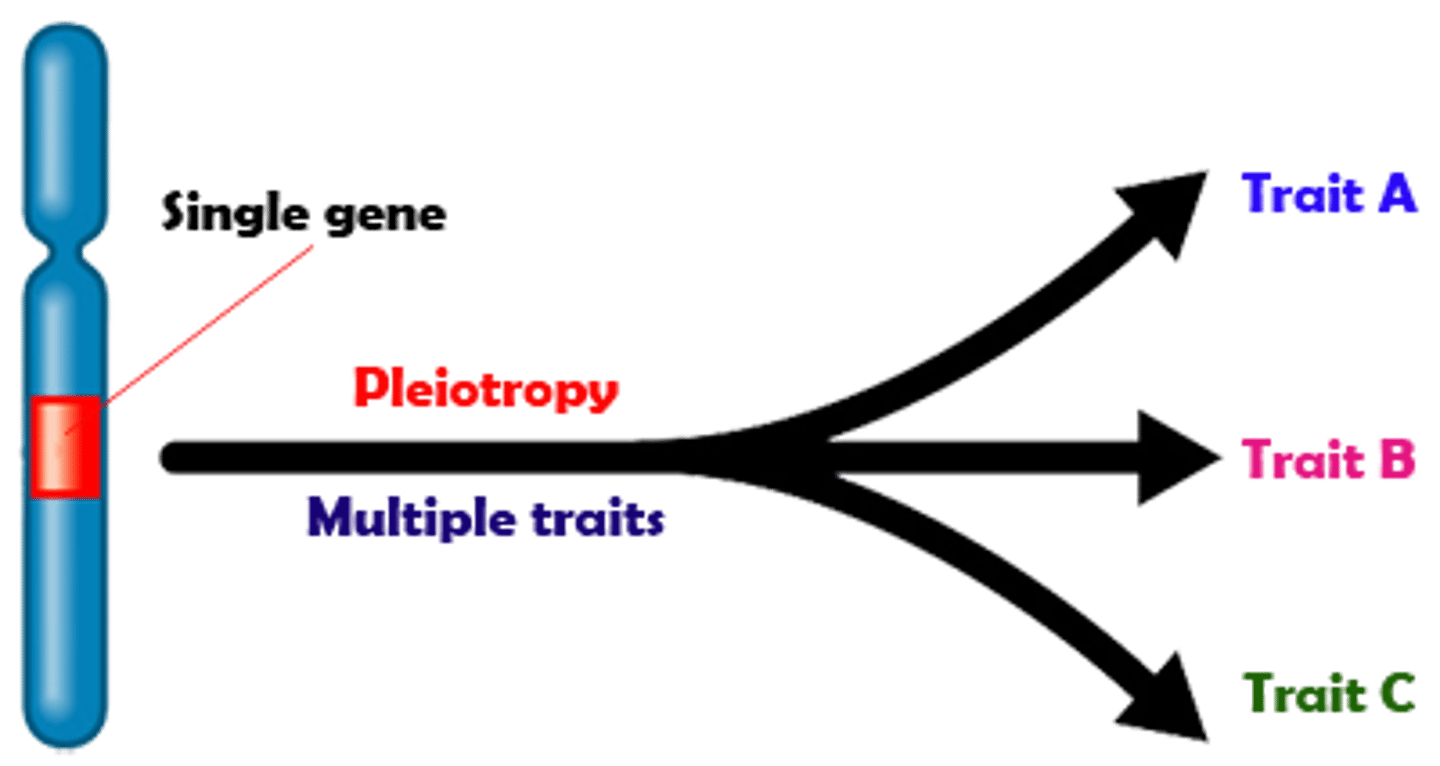
Epistasis
a gene at one locus alters the phenotypic expression of a gene at a second locus

Cystic Fibrosis
A genetic disorder that occurs in people with two copies of a certain recessive allele; characterized by an excessive secretion of mucus and consequent vulnerability to infection; fatal if untreated
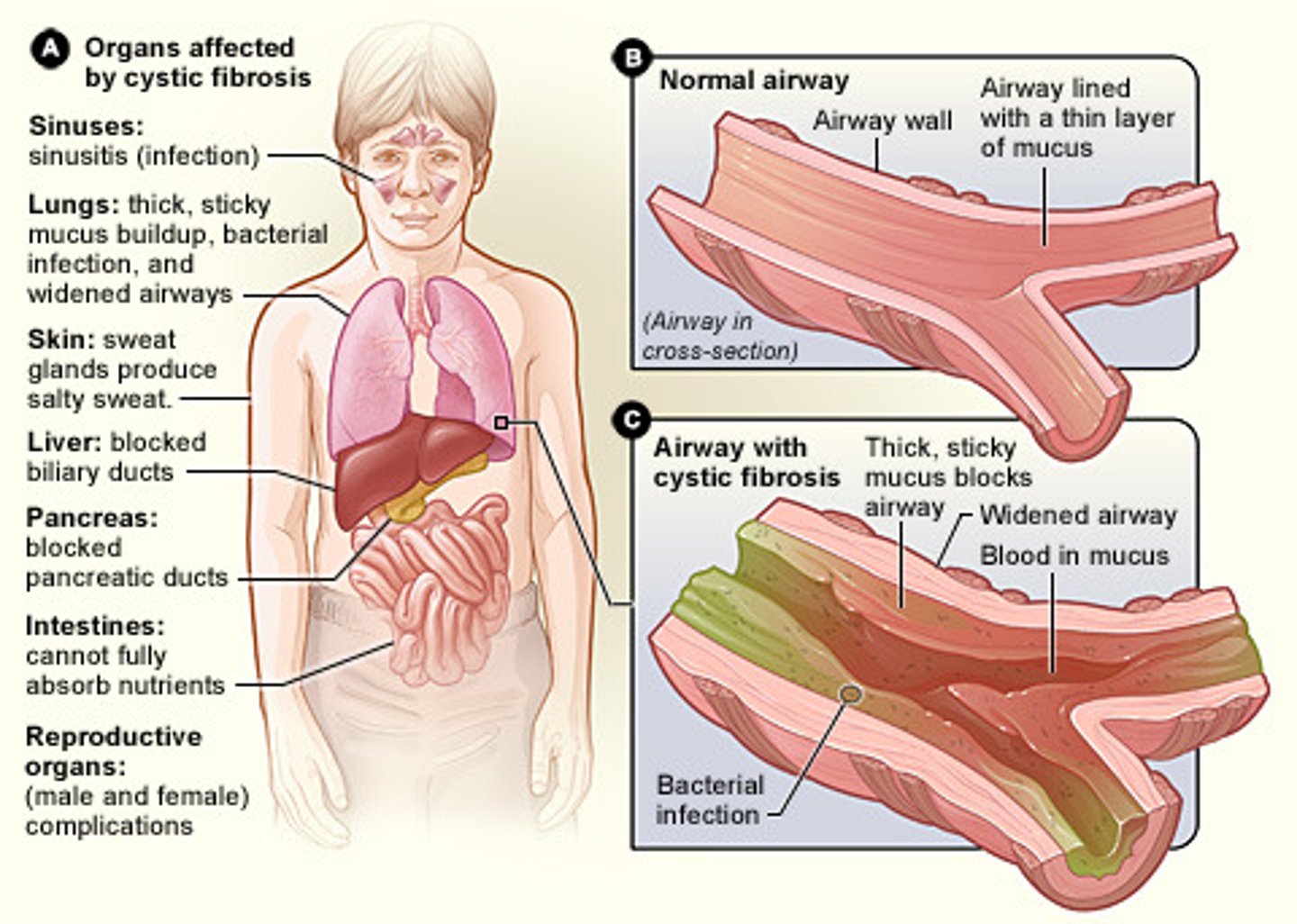
Sickle-cell Disease
- caused by the substitution of a single amino acid in the hemoglobin protein in red blood cells
- symptoms include physical weakness, pain, organ damage, and even paralysis
What is an environmental effect that can effect gene expressions?
temperature
Sex-Linked Traits
- a gene that is located on either sec chromosome
- the human X chromosome has 1,000 genes and the Y chromosome has 78 genes (the gene called SRY on the Y chromosome is responsible for the development of the testes in the embryo, thus making it the Y chromosome the sex determinant in males)
short segments on the Y chromosomes are homologous with the X chromosome and allows them to behave like homologs
Non-disjunction
Error in meiosis in which homologous chromosomes fail to separate; this causes mutations in the chromosomes that result in Downs', Turner's, and Klinefelter's Syndrome
Aneuploidies
abnormal number of chromosomes resulted from the fertilization of gametes in which non-disjunction occurred (ex. Downs' syndrome)
Know about sex determination in "birds and bees"...
"Birds" or males:
- has genotype ZZ in male birds
- has genotype XO in male grasshoppers and roundworms
- haploid # of chromosomes
"Bees" or females:
- has genotype ZW in female birds
- has genotype XX in female grasshoppers, roundworms, and humans
- diploid # of chromosomes
Name the 4 alterations of chromosome structures
1. Deletion
2. Duplication
3. Inversion
4. Translocation
Deletion
removes a chromosomal segment
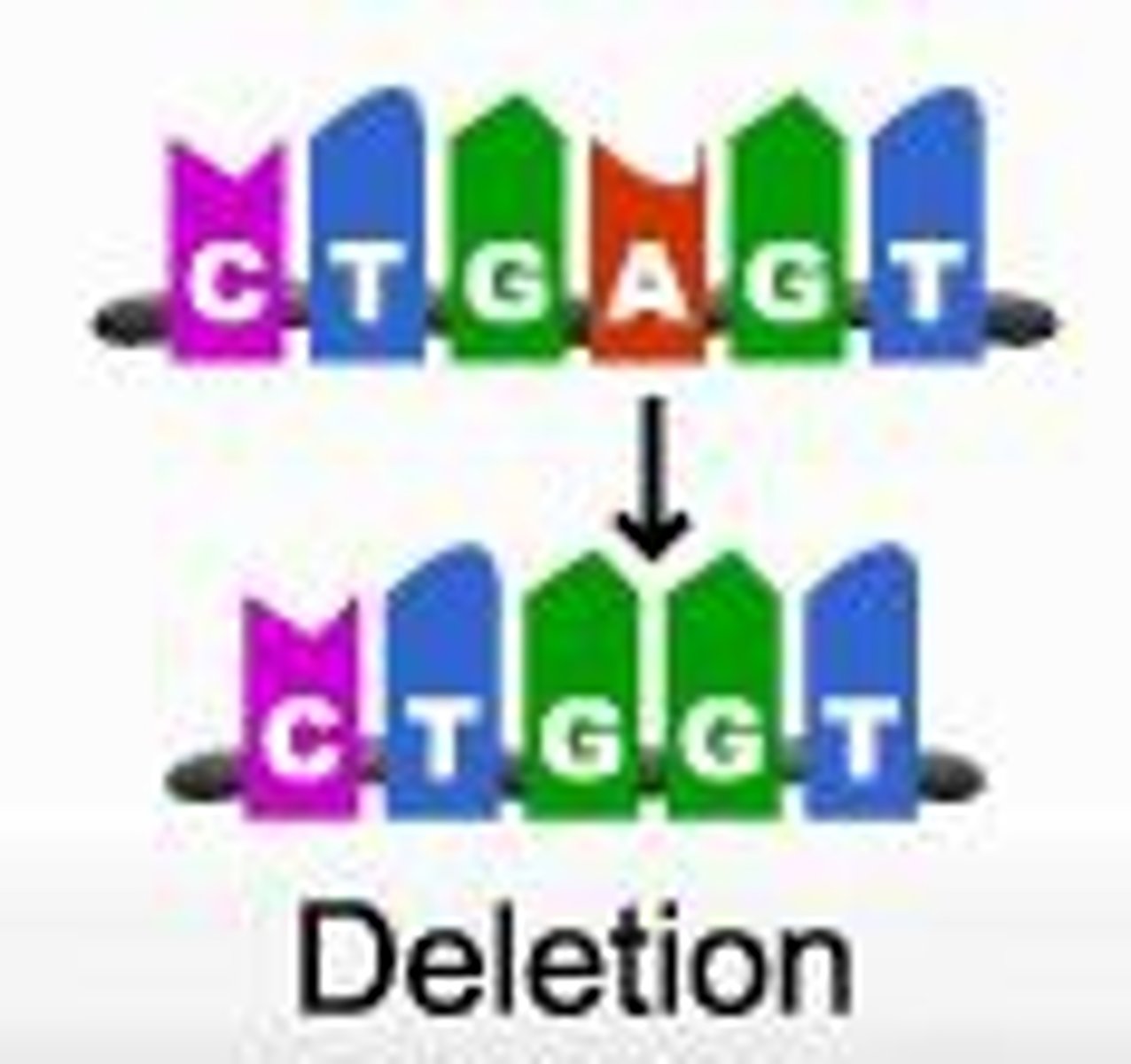
Duplication
repeats a chromosomal segment
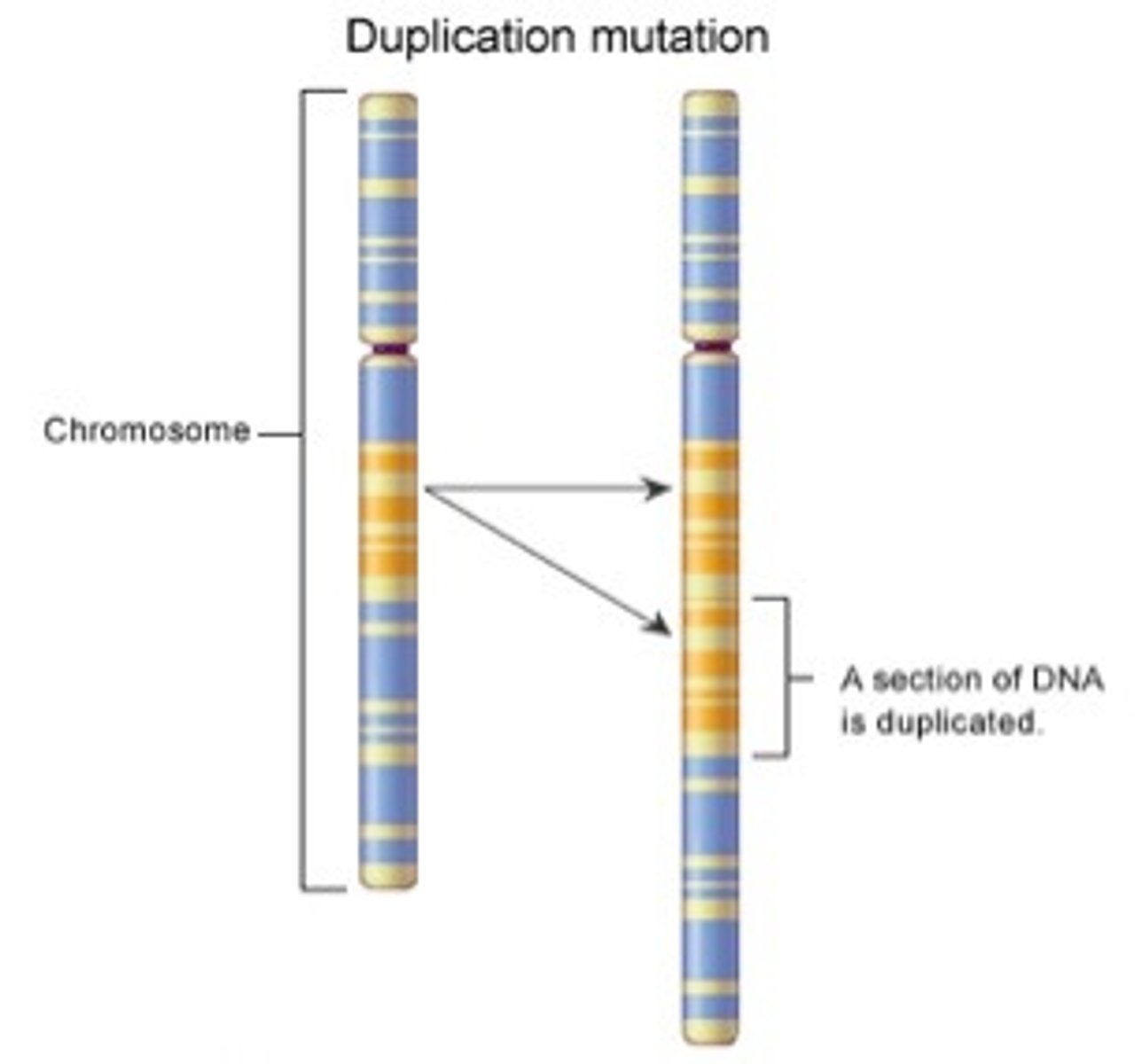
Inversion
reverses orientation of a segment within a chromosome
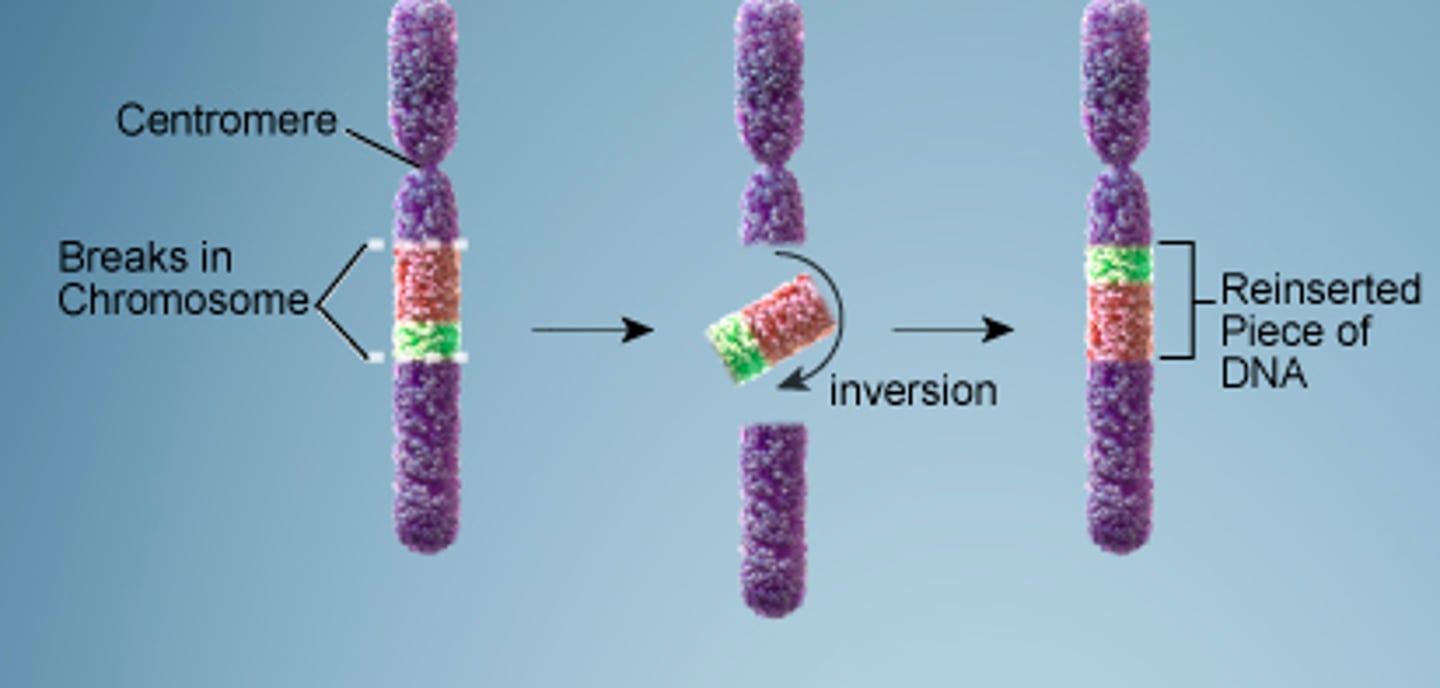
Translocation
moves a segment from one chromosome to another

What are the conditions for which a recessive X-linked trait to be expressed?
1. a female needs two copies of the allele (homozygous)
2. a male needs only one copy of the allele (hemizygous)
( X-linked recessive disorders are more common in males than females because males have one less X sex chromosome than females)
Name the 3 common disorders caused by recessive alleles on the X chromosome in humans
1. color blindness
2. Duchenne Muscular Disorder
3. Hemophilia
Hemizygous
A gene present on the X chromosome that is expressed in males in both the recessive and dominant condition
Why can't males be homozygous or heterozygous for a sex linked trait?
because this would require males to have two X chromosomes, one with the dominant allele and one with the recessive allele; so since males only have one X they cannot be heterozygous or homozygous for these traits...only hemizygous
Polyploid
condition in which an organism has extra sets of chromosomes
- 3n = triploid, 4n = tetraploid, 5n = pentaploid, 8n = octaploid, and so on...
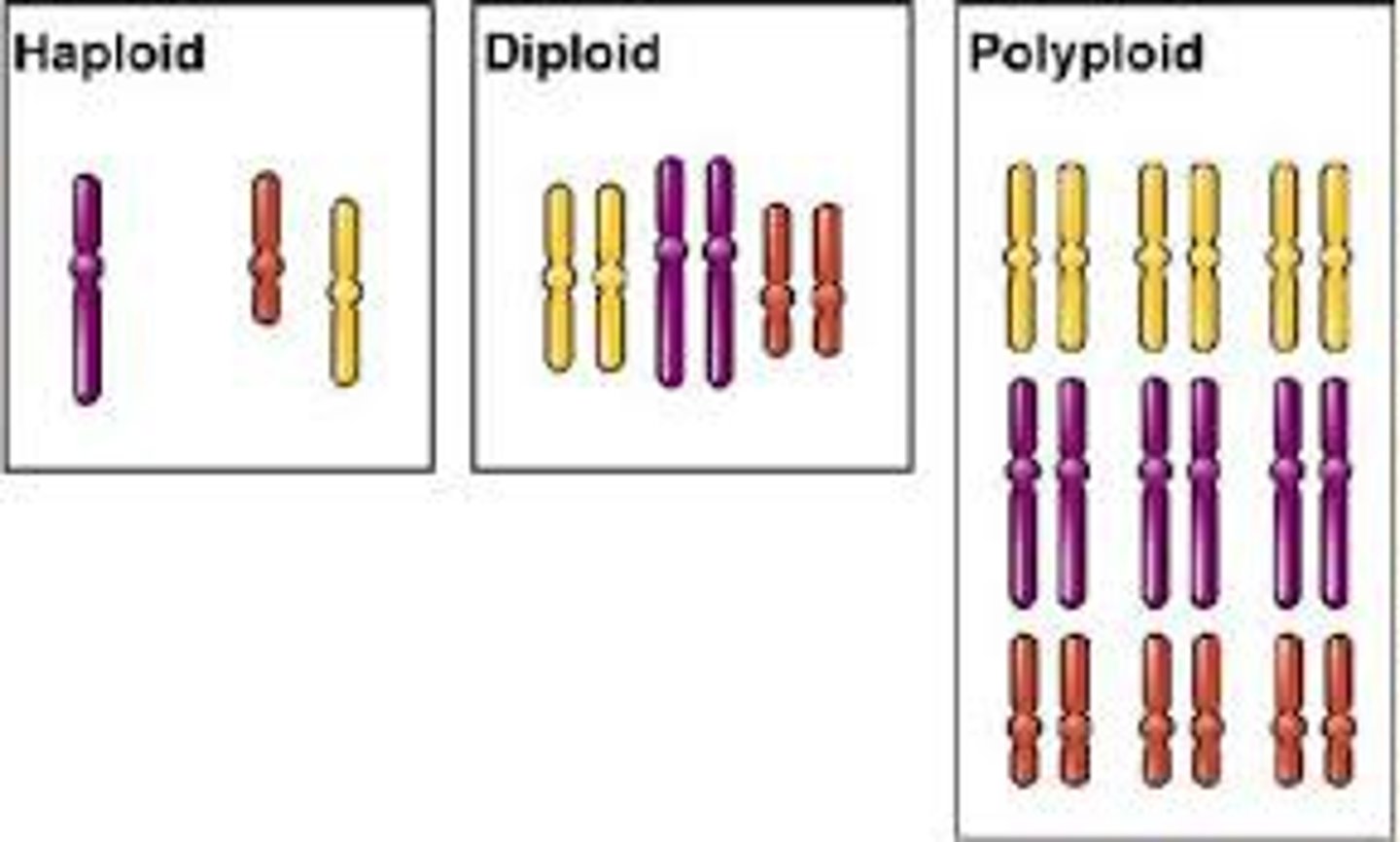
Down syndrome-trisomy 21
an aneuploidy due to nondisjunction
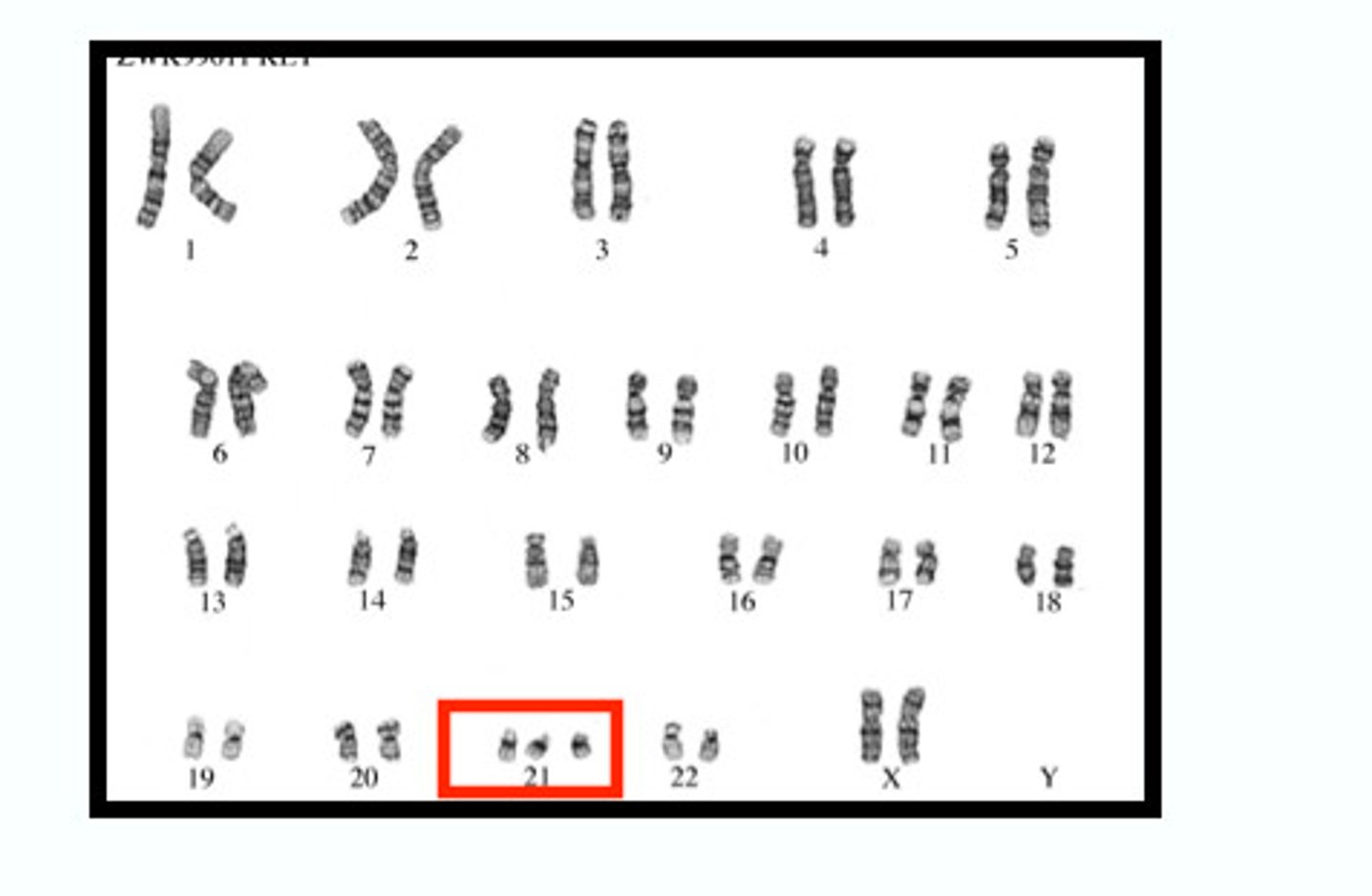
Klinefelter's syndrome (XXY)
- males have an extra X chromosome, causing feminine body shape
- aneuploidy due to nondisjunction
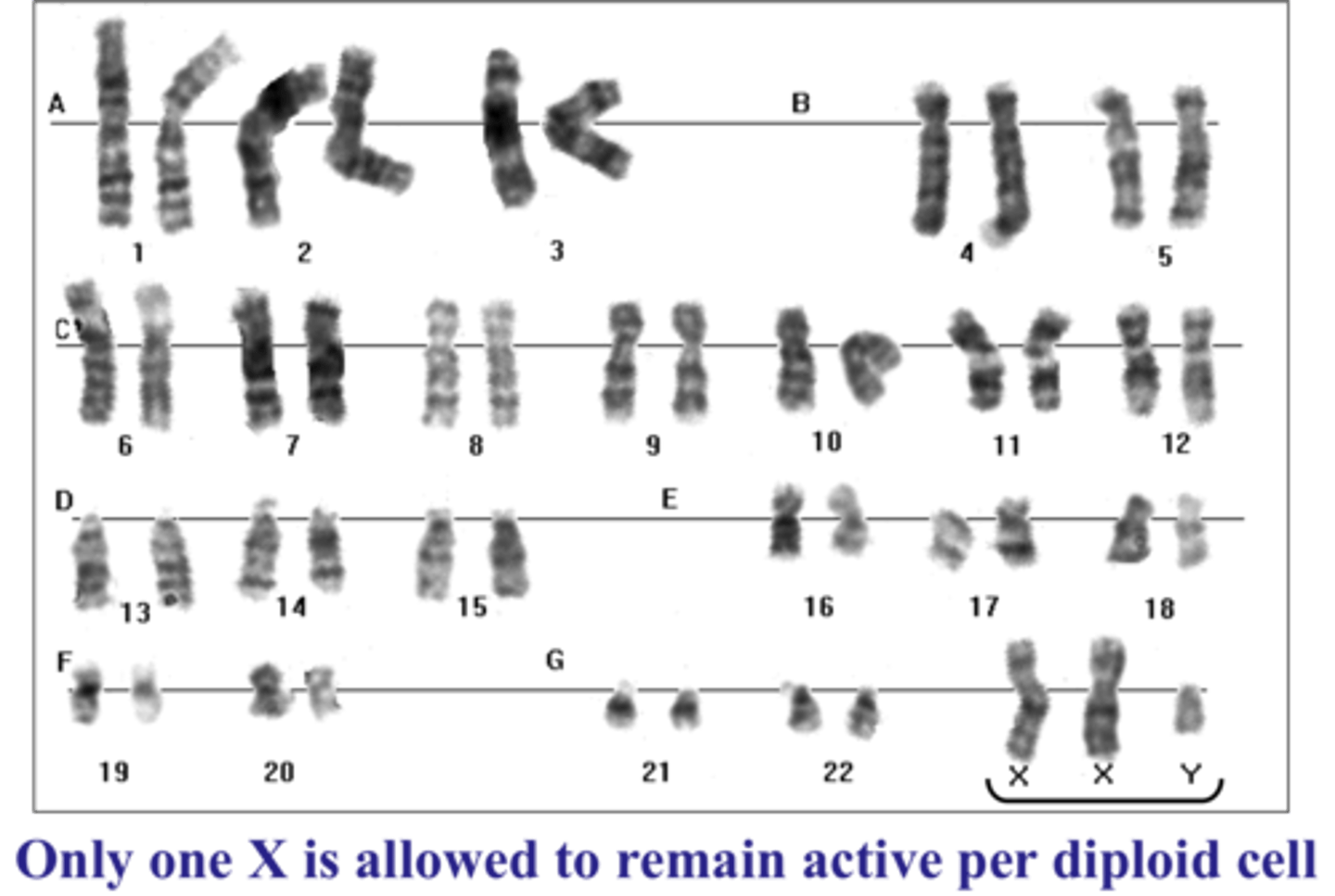
Turner Syndrome (Monosomy X)
produces X0 females, who are sterile; it is the only known viable monosomy in humans
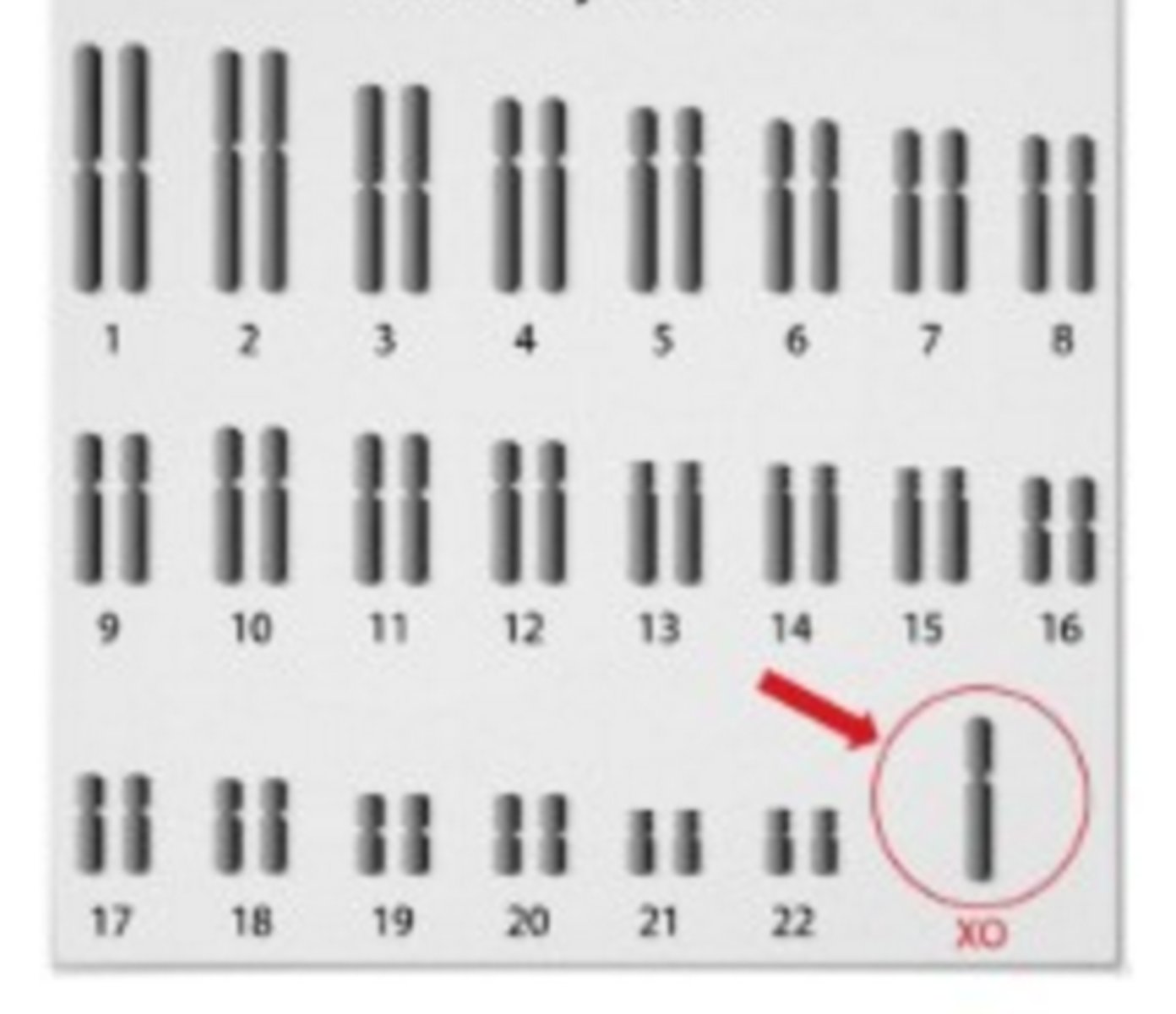
Hemophilia
An X-linked recessive disorder in which blood fails to clot properly, leading to excessive bleeding if injured.
Color Blindness
A sex-linked trait in which an individual cannot perceive certain colors.
Hershey-Chase Experiment
- showed that DNA is the genetic material of a phage known as T2
- their experiment also showed that only one of the two components of T2 (DNA or protein) enters an E coli cell during infection
- used sulfur, phosphorus, and bacteriophage viruses
- concluded that the injected DNA of the phage provides the genetic information
- proof that viral DNA can program cells

Semi-conservative Replication
in each new DNA double helix, one strand is from the original molecule, and one strand is new
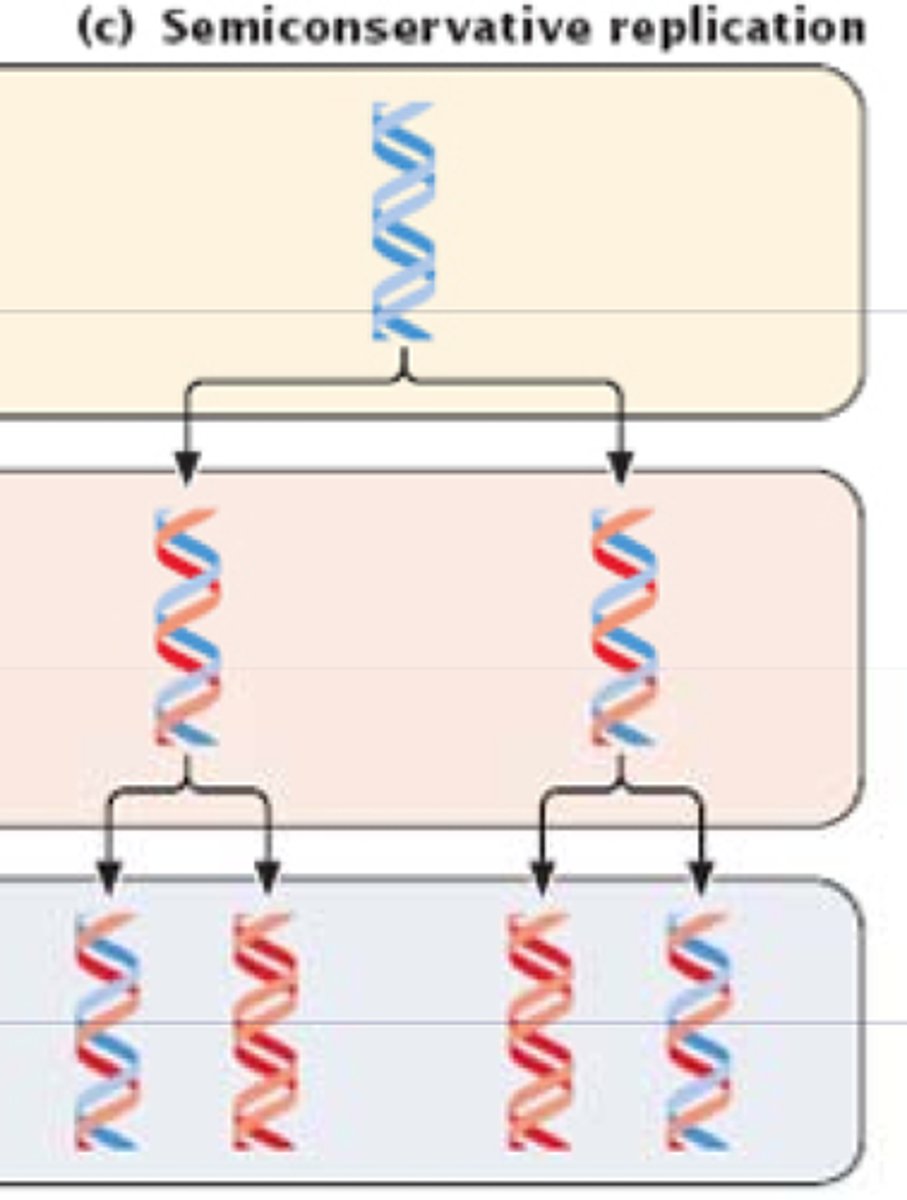
Helicase
An enzyme that untwists the double helix at the replication forks, separating the two parental strands and making them available as template strands.
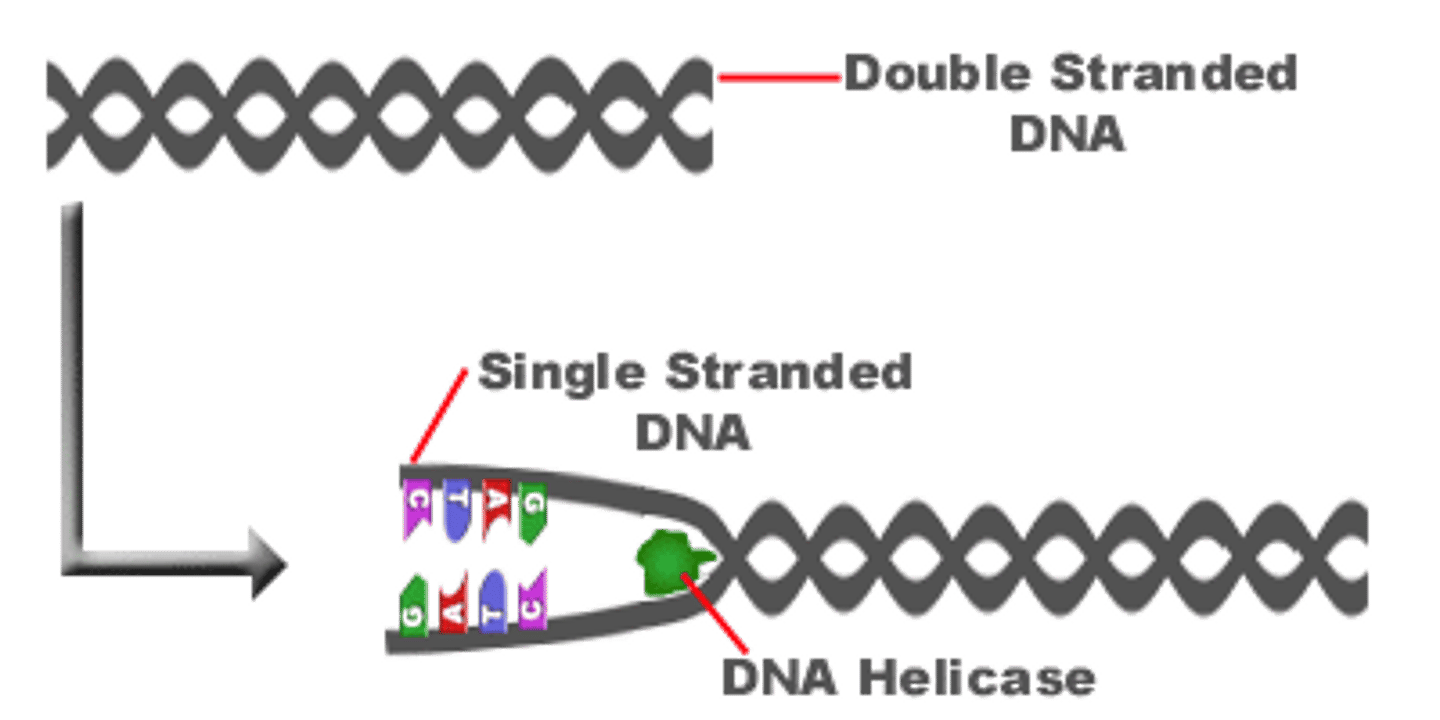
Ligase
An enzyme that connects two fragments of DNA to make a single fragment
Topoisomerase
corrects "overwinding" ahead of replication forks by breaking, swiveling, and rejoining DNA strands
Primase
An enzyme that joins RNA nucleotides to make the primer using the parental DNA strand as a template.
Leading Strand
The new continuous complementary DNA strand synthesized along the template strand in the mandatory 5' to 3' direction.
Lagging Strand
A discontinuously synthesized DNA strand that elongates by means of Okazaki fragments, each synthesized in a 5' to 3' direction away from the replication fork.
DNA polymerase I
removes the RNA primer and replaces it with DNA
DNA polymerase III
adding bases to the new DNA chain; proofreading the chain for mistakes
Origin of Replication
Site where the replication of a DNA molecule begins, consisting of a specific sequence of nucleotides.
Okasaki segments
Short segments of complementary DNA formed when DNA polymerase assembles DNA on the 5' to 3' strand; caused b/c polymerase must return to replication fork after each segment; connected by DNA ligase.
single strand binding proteins
bind to the unpaired DNA strands, keeping them from re-pairing
Replication Fork/Bubble
- A Y-shaped point that results when the two strands of a DNA double helix separate so that the DNA molecule can be replicated
- Single fork in Prokaryotic cells
- 100s of forks in Eukaryotic cells
- Replication will proceed in both directions (form a bubble)
Bacteriophage
viruses that infect bacteria
Pyrimidines
cytosine (C), thymine (T), uracil (U in RNA)
- have one hexagonal ring
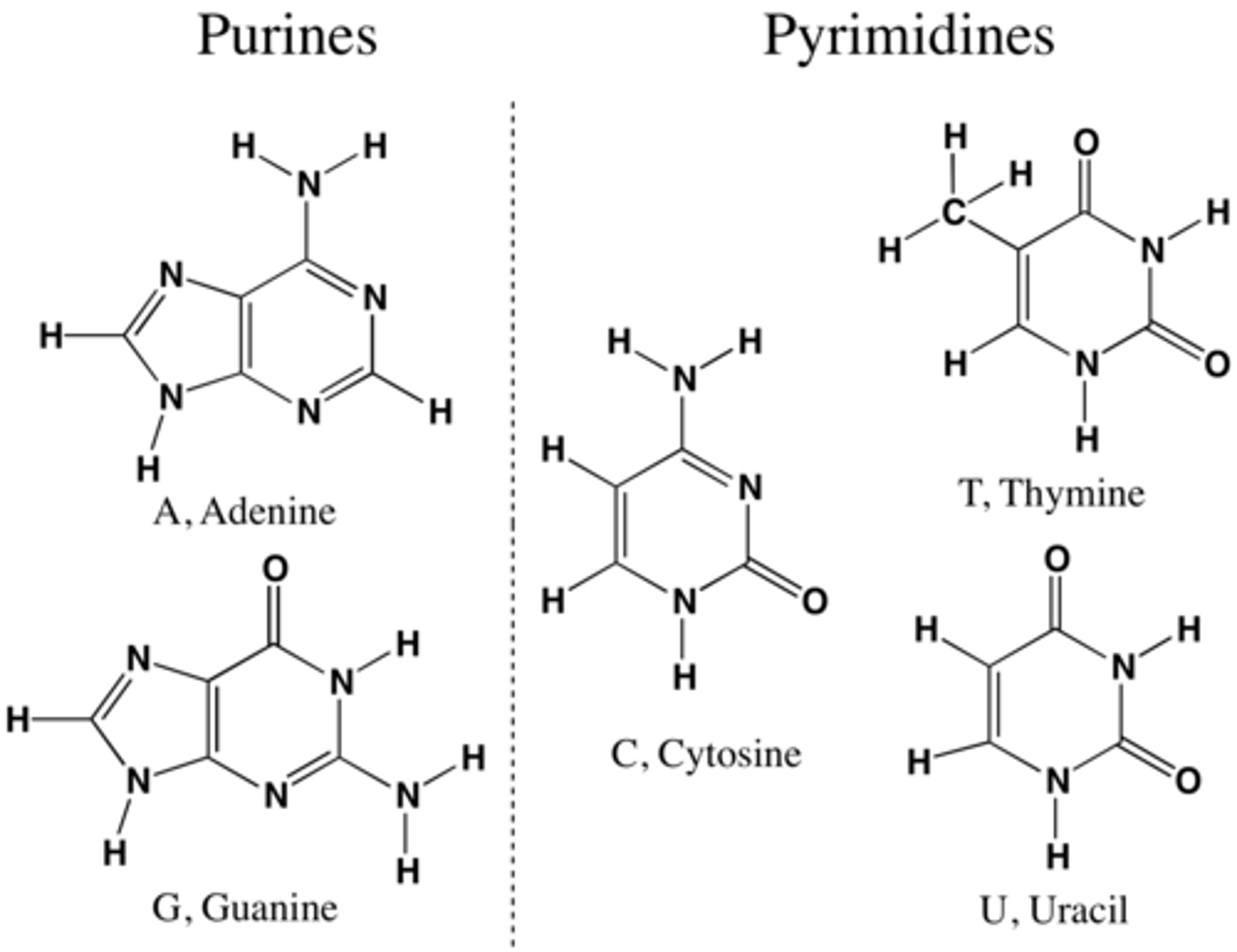
Purines
guanine (G) and adenine (A)
- has 2 rings in structure

Describe the structure of DNA.
DNA is a polymer built from many nucleotides chained together via phosphodiester linkages
What is a nucleotide, what is a nucleotide composed of?
nucleotides contain:
- a pentose sugar
- a phosphate group (gives DNA a negative charge)
- a nitrogenous base (adenine (A); guanine (G); cytosine (C); thymine (T); and uracil (U)
- adenine guanine and cytosine are found in both DNA and RNA; thymine is only found in DNA, uracil is only found in RNA
How many hydrogen bonds are between A and T?
2 hydrogen bonds
How many hydrogen bonds are between C and G?
3 hydrogen bonds
Antiparrallel
The opposite arrangement of the sugar-phosphate backbones in a DNA double helix.
Who discovered the paring rules and the antiparallel nature of DNA structure?
Watson and Crick
Who discovered the double helix shape of DNA by using X-RAY diffractions of crystals of DNA molecules?
Rosalind Franklin
Conservative Model
the two parent strands rejoin
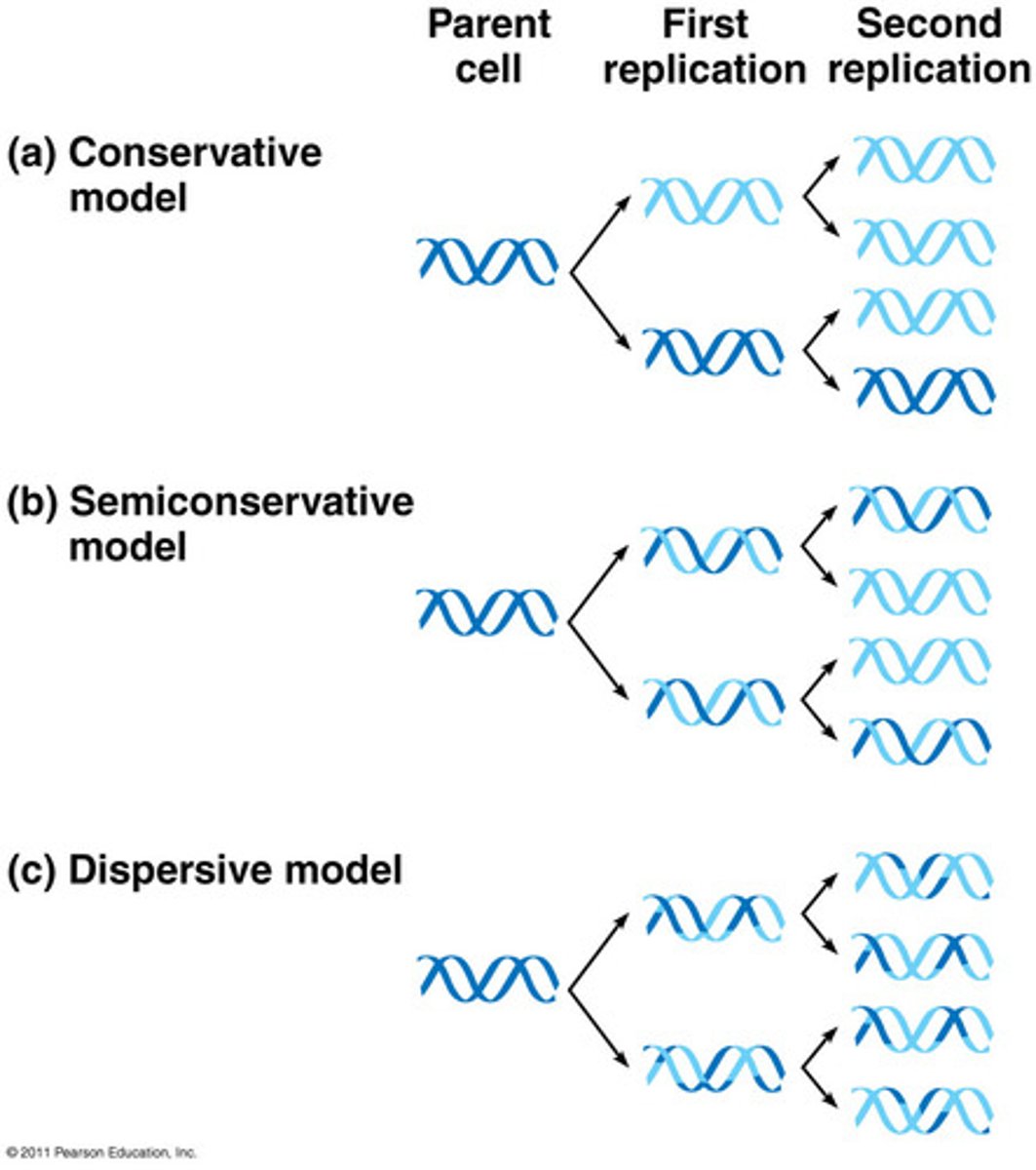
Dispersive Model
each strand is a mix of old and new
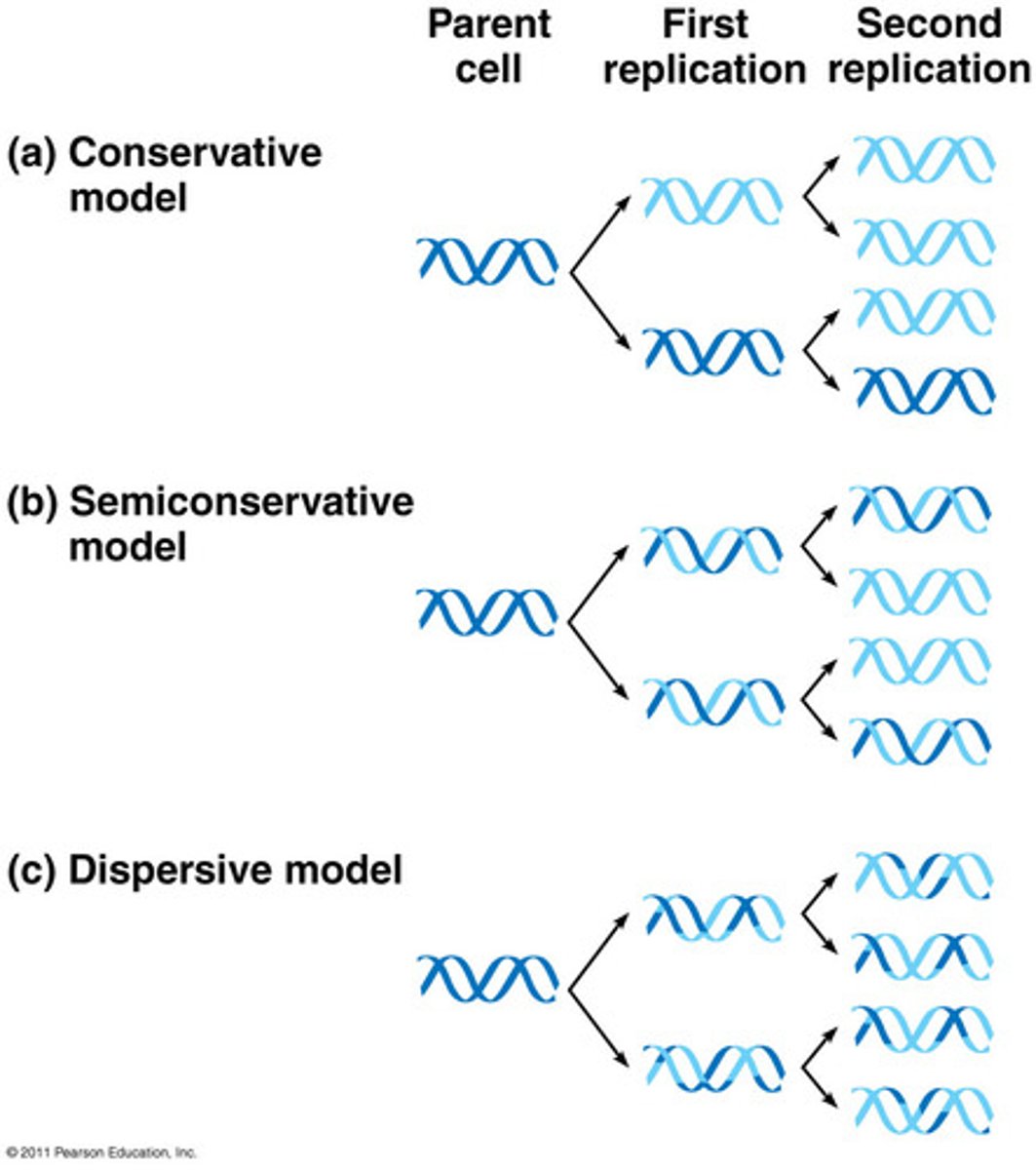
Describe the steps of DNA replication.
1.Unwinding and separating DNA strands
2.Adding complementary bases
3.Formation of two identical DNA molecules